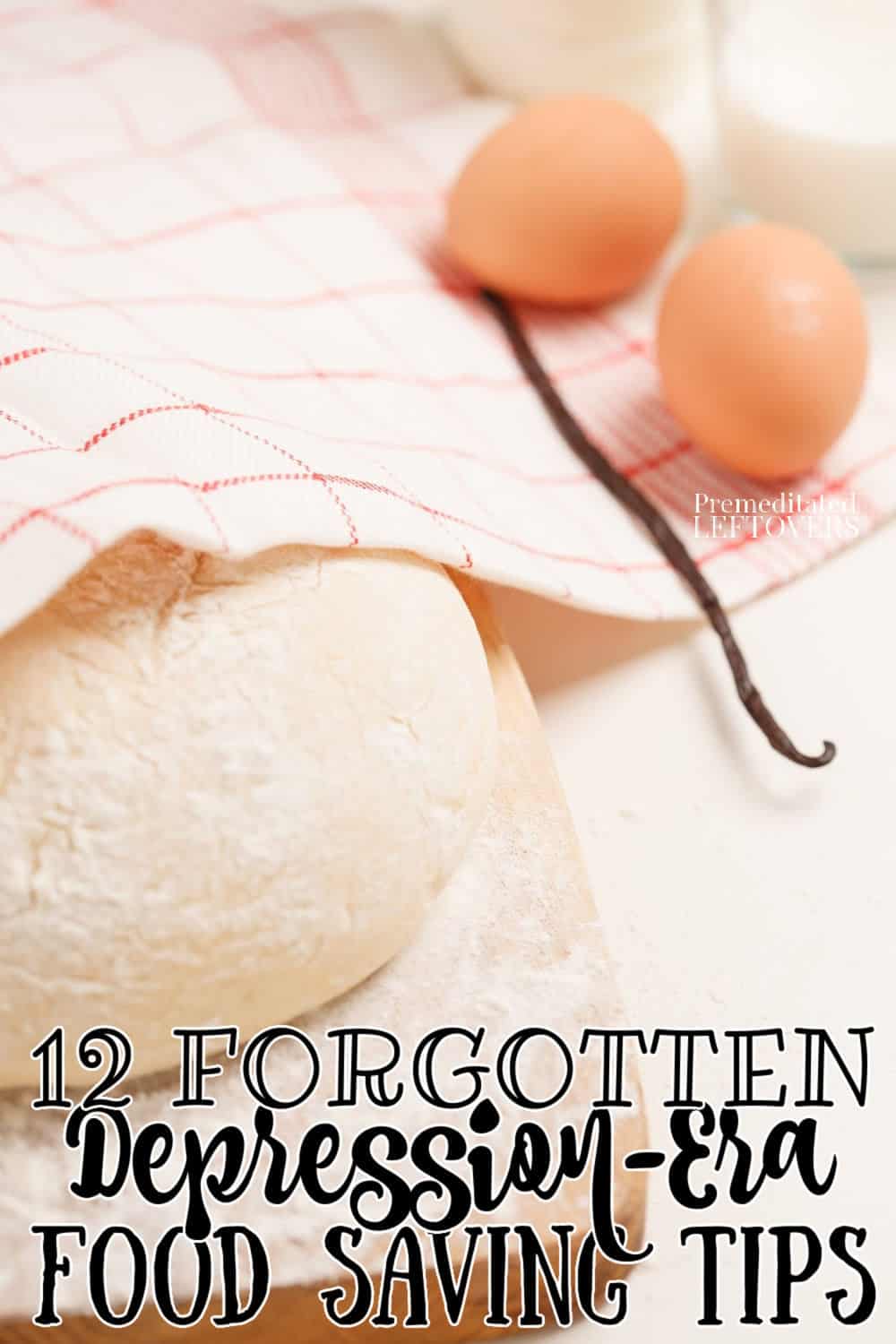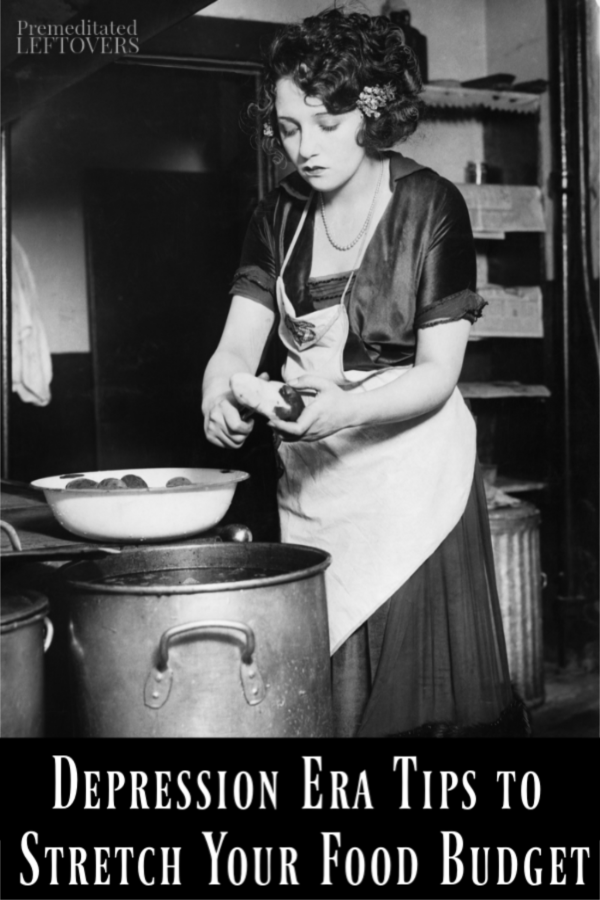Use these Great Depression Era tips to stretch your food budget and save money on groceries.

Living frugally is not a new thing even though it seems to be something that is taking off again. During the Great Depression Era, there was no choice but to live as frugally as possible. Families made clothing out of flour sacks, went without, and made do, and they were masters of stretching food budgets. Many people had large families and very little money to spend on food.
While some of the things they did during the depression may not be practical for today or they may even be more expensive to do now, it is a good idea to look back on this time and search for the practical tips that we can use today to save money. We can examine how large families were able to feed everyone with so very little and apply it to our own budgets. Here are some depression-era tips to stretch your food budget and help you save money.
Depression Era Tips to Stretch Your Food Budget
Keep breakfast simple.
There are a lot of foods that are cheap and filling that make an excellent breakfast. It’s alright to have lots of carbs in the morning in the form of oats if you are going to be using them. Here are 5 make-ahead oatmeal recipes.
While eggs and dairy were scarce in the cities during the Great Depression, they were available in rural areas. Keep yourself feeling fuller longer with cheap sources of protein like eggs, yogurt, or cottage cheese.
Pack your lunch.
Buying a meal at a fast restaurant is now over $10 in our area. That is $50 a week! Get in the habit of packing your lunch each evening when you are cleaning up after dinner. You are more likely to follow through on your resolution to pack lunches if you do it the night before rather than try to remember to do it in the morning. You can quickly pack a lunch by adding a container filled with last night’s leftovers from dinner to a brown bag and a piece of fruit. Not only will you save money by not eating fast food for lunch, but you will also reduce food waste, and eat a healthier meal. If you end up making sandwiches, here are tips to prevent soggy bread so you can make them the night before.
Bring your own coffee.
My Grandpa and Dad both took a thermos of coffee with them when they left for work. It is even easier to bring your own coffee today with travel mugs. Stopping for a coffee on the way to work is not only expensive, but it also wastes time. If you have a coffee maker, you can set everything up the night before, then just turn it on in the morning, and in a few minutes, you will have hot, inexpensive coffee to get you moving! Save even more by making homemade coffee creamer.
Make your own convenience foods.
There were very few convenience foods during the depression era. In today’s world, it is hard to avoid buying a few convenience foods here and there, but try to cut your use of convenience foods as much as possible and make your own. You will find that you can make larger amounts for less in most cases. Batch cook rice from scratch instead of buying packaged instant rice. Then store it in usable portions in your refrigerator or freezer for a frugal and quick side dish. Broil a couple of pounds of chicken then dice it to use in recipes instead of buying precooked chicken strips. Here are some batch cooking video tutorials to get you started.
Switch to less expensive cuts of meat.
Meat can be very expensive now, but you can make a few frugal swaps to save money. Buy chicken thighs instead of breasts. Or better yet, buy a whole chicken and stretch it for several meals. Brisket became popular not because it was a family favorite, but because it was an inexpensive cut. Look for chuck roasts instead of sirloin or other popular cuts and you will save money. You can cut up a roast into strips for fajitas or bite-size pieces for a casserole. Cutting the meat into smaller pieces yourself will usually save you at least 25% over precut meat.
Stretch the meat in meals with beans.
Beans are more than just great on a burrito. They have a wonderful texture and when added to recipes, they can stretch your meats twice as far. You can also substitute beans for meat in recipes, too. To really save yourself a good amount of money, buy them dry and in bulk rather than in a can and cook them yourself. If your family doesn’t like beans, then try lentils. They are smaller and work well when mixed with ground meat.
Grow some of your own food or forage.
You can garden and grow some of your own foods even if you don’t have a large yard. If you can hang a basket, you can grow salad greens in it. Grow herbs in jars on your kitchen counter. Potatoes can be grown in a barrel and many vegetables can be grown in containers on a patio. You can plant berries and fruit trees in your yard and have edible landscaping.
You can also forage for some things, too. Just make sure you know how to properly find edibles in the wild. Here are tips on foraging.
Make a pot of soup every week.
When people cooked during the great depression, nothing was wasted. Our grandmothers made broth from chicken bones, and used vegetables and small bits of meat and leftovers to create soups on a weekly basis. You can add a ham bone while cooking peas to make a flavorful pea soup or beef bones to beans while they cook to make a pot of delicious bean soup. No bones? Then make minestrone soup and add whatever vegetables you have available to you.
Learn some frugal recipes to keep in your rotation.
Knowing some frugal recipes to keep in your regular rotation was something many home cooks did during this time because there were very few instances that people could afford anything fancy. While it is true families often ate the same things over and over, it did cut costs dramatically. You don’t need to bore your family with the same 5-6 meals each week, but you should make sure you keep an arsenal of low-cost meals to keep in your meal plans. Here are some frugal depression era recipes that you can incorporate into your meal rotation.
Serve root vegetables.
Root vegetables like potatoes, sweet potatoes, carrots, and beets have fallen out of favor. But root vegetables are filling and inexpensive. If you are worried about the carbs in potatoes, cook the potatoes, then let them cool. This will transform much of the starch in the potato into resistant starch which functions as a soluble fiber. Batch cook potatoes or sweet potatoes in the oven on the weekend and store them in the refrigerator for use in meals throughout the week.
Make frugal Snacks.
Popcorn became popular during the Great Depression because it was a low-cost, filling snack. It can also be a healthy snack if you make it from scratch as Grandma had to do instead of buying microwave bags. Cook popcorn kernels in a large pot in a little oil or in an air popper, then add salt.
Look for other frugal and filling snacks such as apple slices dipped in peanut butter instead of reaching for expensive and unhealthy packaged snacks.
Drink water.
An easy way to save money is to drink water instead of juice or soda. Take a reusable water bottle with you whenever you leave the house so that you won’t be tempted to buy a soda when you are out doing errands. Not only is water so much better for you, it only costs pennies if you fill your water bottle up at your kitchen tap.

Do your own baking.
Baking at home will, not only, save you money but will also be slightly better for you because you have complete control over the ingredients.
Homemade Bread Recipes:
Irish Soda Bread (no yeast required)
Rustic French Bread (1-hour recipe)
Basic White Bread (great for sandwiches)
Even though baking supplies were in short supply, desserts occasionally graced the table during the Great Depression. Both of these cake recipes are made without using eggs, butter, or milk which were scarce during the depression.
Vanilla Depression Cake Recipe (sometimes called Whacky Cake or Crazy Cake)
Chocolate Depression Cake Recipe (sometimes called Surprise Cake)
Tomato Soup Cake Recipe (Sometimes called Mystery Cake)
More Depression Era Dessert Recipes
More Depression Era Recipes
Depression Era Breakfast Recipes
Frugal and Filling Depression Era Meals
More Depression Era Money Saving Tips:
Money Saving Tips from the Depression Era
8 Forgotten Depression Era Money Saving Tips
Depression Era Jobs to Make Extra Money







Renee says
Thanking Myna for her perfect answer to Amanda’s comment. Personal history is also a factor here, not to mention differences in our upbringing. A woman who grew up learning various skills at her mother’s or grandma’s side has a wealth of knowledge and abilities going in. One who grew up “privileged” might never have learned any cooking, cleaning or other household skills. It takes years of practice to bridge that difference and having too little time with a new baby is hard enough without being bullied into doing something unfamiliar.
Amanda, once you are in a place where you have time and interest in doing some of these things, enjoy that journey along with your little one. The learning and doing together are great ways to bond. Best of both worlds to you!
Kay says
I thought this was supposed to be about saving money, trying new things and not wasting so much of our money. That’s what I got out of it anyway. Seems like some just want to complain and chastise people. If you don’t like the suggestions or the innocent comments some have made, nobody is making you read them. I like EVERYTHING on this site.
Kiki says
OP, could we possibly have instructions on how to can the old-fashioned way? (before Instant Pots, I mean).
I’m struggling to find good resources to teach method, not just recipes. Google has slightly helped, but I don’t know how to sort good resources from bad resources!
datalady says
The Ball canning book, that is available with the canning supplies, is the best resource I’ve found. That’s how I learned to can. It’s pretty easy!
Jane Fenters says
Love reading all this ladies. Been living that way for years. Retired 4 yrs ago and now can really make a difference. But please stop with the religious attitude (per the first response). We are a nation of different beliefs or non-beliefs and that is as it should be. Unite, don’t divide.
Jen says
Love the post! I am a stay at home wife and homeschool mom of 4. I try to teach my kids how to live and cook frugally. My grandmother never wasted anything. I sat with her while she made homemade biscuits and canned EVERYTHING! Daily life with 4 kids, homeschooling, and keeping house and cooking good wholesome meals is time consuming but I love every minute. God has blessed me by allowing me to be home with my kids and providing them what they need in life through teaching. If we could all spend time with our families and “step back in time” when families were #1 life would be so much better.
BB says
I too do what I can to save time & $. When making soups, casseroles, bread, meatloaf or anything else that freezes well I make 2. 1 for now & 1 for freezer. Cook once, eat twice!
Elizabeth says
Myna has it right! Amen! Amen! and Amen!
Bev says
Here’s another Depression-era tip to add: use coffee grounds twice. My mom showed me how she would take the grounds leftover from making coffee (she had a percolator coffee pot on the stove) and use them to make a second pot of coffee. All you need to do is refrigerate the first batch of used coffee grounds, then add it to the second batch of used coffee grounds and make your coffee. Using twice as much used grounds as you would fresh grounds stretched the money she had.
Alea Milham says
Great tip! Thanks for sharing!
Michelle says
It’s interesting to learn how families used to get by on less. I incorporate as much as I can, not so much for need, but more out of wanting to be self-sufficient. We garden, forage, and hunt. I love using what we’ve procured ourselves.
Kim says
Can I just get an Amen for Myna back there ??????? What an amazing story and attitude. Thank you so much for sharing!
M says
Amen for Myna and God bless her I am saving soap box speech it is truly an inspiration and thank you Myna you bring strength and peace.
Lynn says
What a fab post I like the depression cooking with Clara on you tube and this post is just fab! Thank you I will be checking in in your blog more often 🙂 xxx
kelly says
How about some recipes?
Alea Milham says
Tomato Soup Cake was popular during the depression and has been passed down from my great grandmother. It is tastes much better than it sounds! We will have more depression era recipes up soon!
Vicki says
Family favourite
Lasagna Casserole
1-2 lb. cooked ground beef drained
3-4 cups cooked elbow macaroni
1 tub of cottage cheese
1-2 lg. cans spaghetti sauce (or home made)
enough grated (cheddar, mozzarella) cheese (about 2 cups ) to make your family smile.
I buy cheese on special and grate it and store it in the freezer.
Combine all 5 ingredients. Place in a casserole dish and heat through in the oven. Amounts can be changed to suit your family’s taste.
Monica @ Boothopia.ca says
Some great ideas here! A big difference between today’s culture and the Depression era is that people generally put more time and effort into making things from scratch back then. If your family eats bread and pasta, you can save a lot by baking your own bread and making your own pasta. I received a stand mixer with a pasta maker attachment as a gift, but you can make pasta without that equipment too. It just takes time and effort!
Found you via Pinterest, looking forward to reading more of your money saving articles!
Amanda says
The problem is that now, people don’t often have time with their long work hours and commutes to put into making things from scratch, not so much that they don’t want to.
I personally would love to make more from scratch but with 50+ hour work weeks, 45 min each way between work/home, and a new baby, it’s tough to find time to cook AND eat. I have gotten creative (using lamp timers on a crockpot and cooking ahead), but it is quite a hurdle.
Sherry says
Mothers worked in the fields and garden they canned their own food my grandma had 9 children did laundry on a washboard did not own a vacuum. And we still have 24 hours in a day that has not changed.
When someone died they all made extra and took to the family. There was a lot less playing and a lot more praying. They feed there family 3 times a day something that they prepared from scratch. Or had previously prepared. Priorities and preparedness and responsibilities have changed but time has not changed.
Debbie says
Amen!
Myna says
Ladies, ladies, ladies; how about you set aside your holier than thou attitude and stop perpetuating the stay at home mom versus the working mom argument that was going on 20 years ago when I first became a mom.
Amanda is telling you she is a new mom and is away from her baby for 12 hours a day and trying to figure it out. You respond by saying she is not doing enough? Really? Which is more important…making homemade pasta or bonding with her child? Hooray for choosing bonding. You go girl.
Yes, a stay at home mom does have the choice to make everything from scratch. Sherry, Debbie, I grew up doing the very thing your depression era grandparents did. We spent the mornings in the fields (it was way to big to be a garden…I’m talking 100 potato plants, 50 tomato plants, 20 squash plants, 10 rows of corn that were 25-30 feet long, and 20 or more rows the same length or longer of beans and peas.) hoeing and gathering the produce we raised. My mom spent hours canning, cleaning, sewing our clothes, laundry and all the other chores to keep the household running. Where was dad? Right there working too when he could after working 40 hours a week in town and another 40 farming 275 acres of cotton and soybeans.
BUT! First, my mom could do these things and cook from scratch because she had the freedom to plan her own day. Honey, my mom was crunchy way back when crunchy was only a choice in peanut butter!
Making bread but the corn needs to be hoed? You mix up the bread and let it rise, then you start hoeing until you need to stop hoeing so you can go to the house, beat down the bread and leave it for a second rise, then go back to hoeing. She did a lot of slow cooking where you could stop by the pot and check on the meal throughout the day and add those green peas later in the day since they do not take as long to cook as the potatoes.
Second, she was wise enough to use all resources available to her. Depression era women understood this also. If they were lucky enough to live in a community of close proximity, they shared and traded. From my own childhood we did this all the time.
My mom provided potatoes to one neighbor and in return she provided us with milk each week. My dad would plow a neighbor’s pea patch and come home with fried pies, and several families would buy two or three pigs to butcher and split the meat all in one frosty day instead of three. My mom and dad did these things because IT WAS A CONVENIENCE and built a sense of community. My parents purchased very little food at the grocery–mainly sugar, floor, grains. My parents provided all these things for us; but believe me, more importantly they partook of every opportunity to work smarter, not harder.
I say hooray to the working mom who is doing what she feels is best for her family. I thank you for having a resource to buy the team soccer equipment when your employer sponsors your children’s team.
I say hooray to the stay at home mom who is doing what she feels is best for her family. I thank you for having the ability to schedule and to adjust your daily schedule so you can chaperone a field trip to ensure all the children learn and come home safe.
It is time to start supporting each other; be willing to use the strength and talent that each mom can bring to the table. How about we follow the golden rule?
Beth says
Sherry, you are so right!
Elizabeth says
Actually midern Americans work way more hours now then they did during tge depression. Now we have work, hime and daycare demands. Moms worked in tge field but didn’t gave to commute an hour each way AND had the kids to help when not in school. Kids also spent a great deal of time playing or working on their own, without direct parental supervision. Not so now. Parents have to be with their children constantly. Im not saying life was easy but tgere was a focus on hearth and home. Now it’s work, work, work…then home.
Tammy says
Amen sister! Such true words
Vicki says
One way to make life easier is when you have a day off or long week-end, make up large batches of a few different meals and divide them into smaller portions to put in the freezer. The initial investment in a small chest freezer will help to stretch your budget. When you are rushed, or not feeling like making a meal, or extra company drops in, you can take something out of the freezer and still have time to do other things. This works for me and I hope it is helpful to you.
Kay says
A small freezer is an excellent purchase!!
Teresa says
We continue to make excuses, and feel sorry for ourselves. The reality is that if you do not make the time you are contributing to the ill health of you and your family. As a single working low income mom of three I had no choice. Getting creative means multitasking, involving the kids in all of the daily chores. They will grumble as teenagers, but will thank you as adults. Trust me, I know!